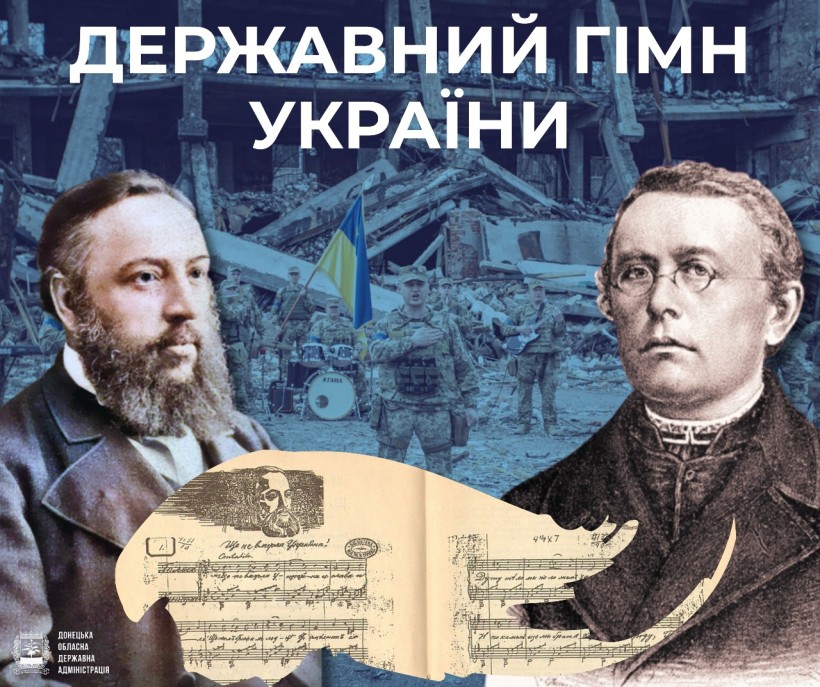
Ukrainian state symbols reflect our history, remind us of the glory of our great-grandfathers, and inspire us to new deeds and accomplishments. State symbols: The State Emblem of Ukraine, the State Flag of Ukraine and the National Anthem of Ukraine are an important attribute of a modern state, symbolizing its sovereignty.
Knowledge of the history of our statehood in its entirety and the history of our state symbols is a powerful force against manipulation of historical facts in the context of Russia's information war against Ukraine. On the occasion of the Independence Day of Ukraine, we offer to delve into the ancient history of Ukrainian state symbols.
When the Main Ruthenian Council came to power in Lviv in 1848, it adopted Father Ivan Hushalevych's poem "Peace to You, Brothers" as the national anthem. In Transcarpathia, at the same time, Oleksandr Dukhnovych wrote the anthem "I am and will be a Rusyn." But it was at that time, in the second half of the nineteenth century, in 1862, that the poem "Ukraine Has Not Yet Died" by the famous ethnographer Pavlo Chubynsky was published in Kyiv. For these poetic lines, the 23-year-old Chubynsky was exiled to the Arkhangelsk province because of his "harmful influence on the minds of the common people." But the poem was nevertheless published in the Lviv magazine Meta.
The composer Mykhailo Verbytskyi liked this text and wrote a musical accompaniment to it. The song was first performed in the village of Mlyni (now part of Poland), where the composer, a young priest, lived. Its first recording took place in October 1910 in Cologne at the Gramophon company. The soloist was the Ukrainian opera singer Modest Mentsynsky. This recording has been preserved and survived to this day.
The piece of music quickly gained popularity in the western Ukrainian lands, and later throughout Ukraine.
During the Ukrainian People's Republic (1917-1921), the composition was considered the national anthem. And during the Soviet Union, the song "Ukraine Has Not Yet Died" was banned as "bourgeois nationalist."
For the first time in the Soviet context, Vasyl Zhdankin, Viktor Morozov, and Eduard Drach sang the Ukrainian anthem in public. It happened on September 24, 1989, on the main stage of the Chervona Ruta festival in Chernivtsi.
On December 1, 1991, the musical version of the national anthem "Ukraine has not yet died" was approved as the national anthem of our country.
On March 6, 2003, the Verkhovna Rada of Ukraine adopted the Law "On the State Anthem of Ukraine". The draft law proposed to approve as the national anthem the National Anthem to the music of Mykhailo Verbytsky with the words of only the first verse and chorus of Pavlo Chubynsky's song "Ukraine Has Not Yet Died". At the same time, the first stanza of the anthem, according to the president's proposal, reads "Ukraine's glory and freedom have not yet died." With the adoption of this law, Article 20 of the Constitution of Ukraine became complete. The national anthem to the music of M. Verbytsky received the words approved by law.
"I am not dead yet..." - is a phrase that symbolizes resilience, even in the most difficult times. This line became the slogan of the Maidan, the Revolution of Dignity, and the fight against the Russian aggressor.
The melody of the anthem has church and marching elements, is easily recognizable, and evokes a strong emotional resonance.
The anthem of Ukraine is a prayer of the nation, a song about the unbreakable will to freedom. It is performed at state events, during flag raising, in moments of sorrow and joy. It is the voice of millions of Ukrainians who believe in their country.